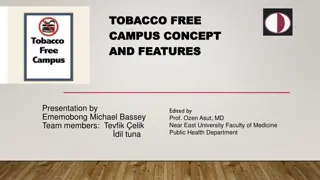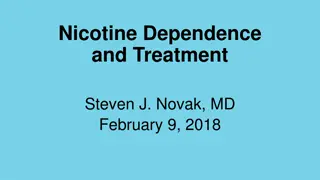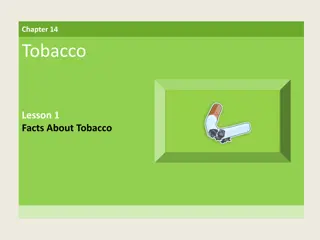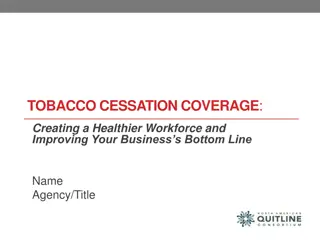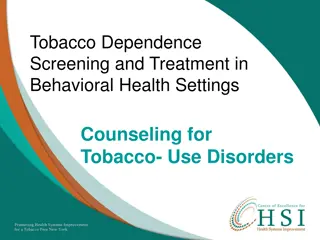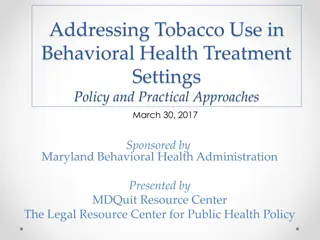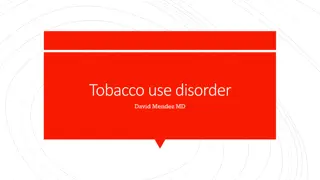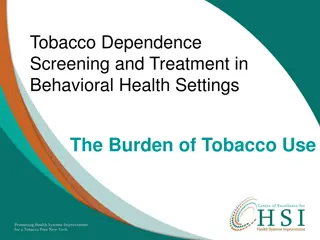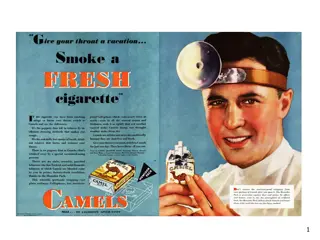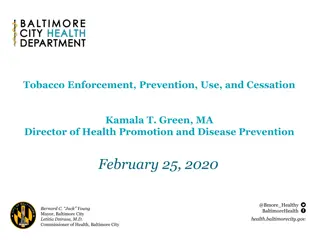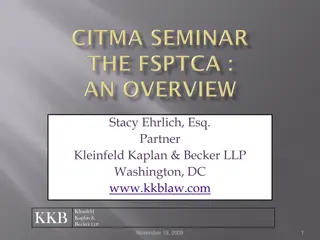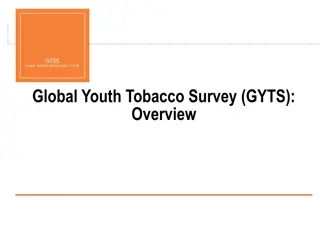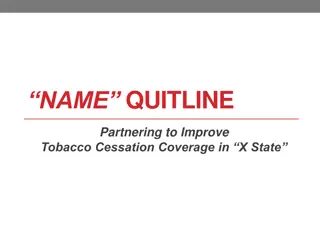Tobacco Dependence Screening and Treatment in Behavioral Health Settings
This presentation focuses on building the capacity of prescribing clinicians in behavioral health settings to integrate best practices for prescribing tobacco cessation pharmacotherapy into standard care delivery. It includes goals, objectives, an agenda, and valuable information on tobacco dependence, pharmacotherapy, behavioral health, and DSM-V criteria for tobacco use disorder.
Download Presentation

Please find below an Image/Link to download the presentation.
The content on the website is provided AS IS for your information and personal use only. It may not be sold, licensed, or shared on other websites without obtaining consent from the author.If you encounter any issues during the download, it is possible that the publisher has removed the file from their server.
You are allowed to download the files provided on this website for personal or commercial use, subject to the condition that they are used lawfully. All files are the property of their respective owners.
The content on the website is provided AS IS for your information and personal use only. It may not be sold, licensed, or shared on other websites without obtaining consent from the author.
E N D
Presentation Transcript
Tobacco Dependence Screening and Treatment in Behavioral Health Settings Prescribing
GOAL To build the capacity of prescribing clinicians in behavioral health settings to integrate best practices for prescribing tobacco cessation pharmacotherapy into standard delivery of care for clients 2
OBJECTIVES As a result of this training, participants will be able to: Describe how tobacco dependence is a chronic relapsing illness Identify the different types of pharmacotherapy available to support a quit attempt Determine the appropriate medications to prescribe to clients based on medical history and drug interactions. Explain nicotine withdrawal symptoms and how pharmacotherapy can assist with a quit attempt 3
AGENDA Welcome, Introductions, Goal and Objectives Behavioral Health & Tobacco Use Prescribers Role in the Integration of Tobacco Dependence Screening & Treatment into Behavioral Health Settings Overview of Pharmacotherapy Case Study Closing 4
WELCOME & INTRODUCTIONS Please share your: Name Agency Role 5
Behavioral Health and Tobacco Use Individuals with mental illness and substance use disorders are more nicotine dependent and therefore require more intensive treatment Pharmacotherapy and counseling strategies must be individualized to each client s needs Integrate into Co-occuring Disorder Treatment -Schroader, SA, Morris CD. Confronting a neglected epidemic: tobacco cessation for persons with mental illness and substance abuse problems. Annual Review of Public Health, 2010; 31:297-314. 7
DSM V Criteria for Tobacco Use Disorder Considered an addiction if 2 or more apply: Withdrawal Tolerance Desire or efforts to cut down/control use Great time spent in obtaining/using Reduced occupational, recreational activities Use despite problems Larger amounts consumed than intended Cravings; strong urges to use 8
PRESCRIBERSROLEINTHEINTEGRATION OFTOBACCODEPENDENCESCREENING & TREATMENTINTOBEHAVIORAL HEALTH SETTINGS 9
Why Should Clinicians Address Tobacco? Addiction to tobacco is a chronic relapsing disorder Tobacco users expect to be encouraged to quit by health professionals Screening for tobacco use and providing tobacco cessation counseling are positively associated with client satisfaction (Barzilai et al, 2001) Failure to address tobacco use implies that quitting is not important 10
Chronic Relapsing Illness Few people quit successfully without treatment To maximize success, combine pharmacotherapy and counseling Treat for as long as it takes Treat to target: No withdrawal symptoms 11
The 5 As Ask about tobacco use and secondhand smoke exposure Advise to quit Assess readiness to quit Assist in quit attempt (brief counseling/referral/ pharmacotherapy) Arrange 11 www.surgeongeneral.gov/tobacco
TOBACCO DEPENDENCE: A 2-PART PROBLEM Tobacco Dependence Physiological Behavioral The addiction to nicotine The ritual of using tobacco Treatment Treatment Medications for cessation Behavior change program Treatment should address the physiological and the behavioral aspects of dependence. 14
NICOTINE WITHDRAWAL Irritability/frustration/anger Anxiety Difficulty concentrating Restlessness/impatience Depressed mood/depression Insomnia Impaired performance Increased appetite/weight gain Cravings 15
FDA APPROVED CESSTION MEDICATIONS Bupropion Varenicline Nicotine Patch Nicotine Gum Nicotine Lozenges Nicotine Inhaler Nicotine Nasal Spray 16
PHARMACOTHERAPY Why use Nicotine Replacement Therapy (NRT) or pharmacotherapy? Improves chances of quitting Makes individuals more comfortable while quitting Allows consumers to focus on changing their behavior Does not have the harmful toxins found in cigarettes and other tobacco products 17
PHARMACOTHERAPY Available over the counter (no prescription needed): NicotinePatch(7mg , 14mg, and 21mg) Nicotine Gum (2mg and 4mg) Nicotine Lozenges (2mg and 4mg) Prescription only: Nicotine Inhaler (the puffer) Nicotine Nasal Spray All NRT can be used alone or in combination Side effects may include: headache, nausea, dizziness 18
NICOTINE PATCH Nicotine absorbed through skin Can take up to 6 hours to reach peak nicotine levels Wear above waist, non-hairy area Do not cut in half Reapply every 24 hours Side effects may include: headache, nausea, dizziness, skin irritation at the site of contact 19
DOSING RECOMMENDATIONS Nicotine Patch: Clients who smoke 1PPD: Step 1 (21mg) Clients who smoke PPD: Step 2 (14 mg Clients who smoke < PPD: Step 3 (7mg) Generally, clients remain on each step for 6 weeks before stepping down 20
NICOTINE GUM Sugar-free Absorbed through lining of mouth - Chew Slowly and Park Two strengths (2mg and 4mg) Flavors are: Original, cinnamon, fruit, mint, and orange OTC as Nicorette or as generic May not be good choice for people with jaw problems, braces, retainers, dentures or significant dental work May irritate the mouth and throat and cause dryness 21
NICOTINE LOZENGE Absorbed through lining of mouth - Moisten then park between cheek and gum line OTC in two strengths (2mg and 4mg) Sugar-free flavors: - Mint - Cherry May irritate the mouth and throat and cause dryness 22
NICOTINE INHALER Nicotine inhalation system: Mouthpiece Cartridge Absorbed through lining of mouth Mimics hand-to-mouth action of smoking Prescription only May irritate the mouth and throat and cause dryness if not used properly 23
NICOTINE NASAL SPRAY Quickly absorbed through lining of nose Gives largest spike of nicotine Prescription only as Nicotrol NS About 100 doses per bottle Side effects may include: sneezing, sore throat, and runny nose and eyes High liability for abuse 24
SMOKING WITH NRT Relatively safe Harm reduction Less reinforcing effects 25
ORAL MEDICATIONS Bupropion SR prescription only Zyban; Wellbutrin SR or Generic Can be used alone or in combination with NRTs Effective among many clients, including those with depressive disorders Non-sedating, activating antidepressant Potential side effects : headache, insomnia 26
ORAL MEDICATIONS Varenicline HCl (Chantix) prescription only Reduces the amount of physical and mental pleasure received from tobacco Dosed in graduating strengths (0.5mg 1mg) Use with NRTs not recommended Recommended length of use is 12 weeks, but can be extended for clients who successfully quit so they can boost their chances of remaining smoke-free Potential side effects: nausea and vivid dreams 27
Smoking Tobacco and Medications Cigarette smoking induces the activity of P450 isoenzyme These enzymes affect how the body metabolizes medications The chemicals in tobacco smoke may interact with antipsychotics, antidepressants, and other medications Desai et al 2001; Zevin & Benowitz 1999 28
Quitting Smoking Tobacco Consider adjusting medications affected by tobacco smoking Nicotine Replacement Therapy does not change present medication levels Smoking Tobacco does affect how Bupropion is metabolized Antidepressants and antipsychotics should be started at the lower end of the dose range 29
Case Study Discuss what would be the best pharmacology choice for the case study on the handout in groups 30
Conclusions Health care providers are the first line in helping smokers quit using tobacco Tobacco cessation treatment increases quitting success rates and should be used in all smokers who are willing to quit Tobacco cessation treatments are effective and well tolerated 31
THANK YOU! 32


